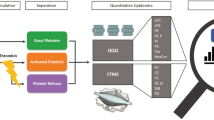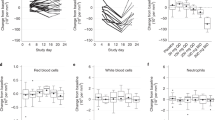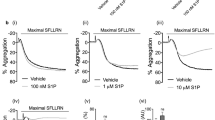Abstract
Platelet activating factor (PAF-acether) is a chemical mediator released by basophils in in vitro and in vivo conditions of immunological challenge1–5. PAF-acether induces aggregation and secretion of platelets from different species3,6,7 and could thus be implicated in various immunological forms of tissue injury8,9. Other sources have been described for this mediator, including macrophages10 and platelets11. As the amounts of PAF-acether released in the latter case are sufficient to support the platelet aggregation11 and as platelet aggregation by PAF-acether does not require ADP secretion or thromboxane biosynthesis12, PAF-acether was proposed as the mediator of the putative third pathway of platelet aggregation11. Structural analysis of PAF-acether by lipases indicated that it could be a glycerophospholipid devoid of an ester linkage at the 1-position and bearing a fatty acid esterified at the 2-position13. This has provided the first evidence for a phospholipid displaying the properties of a powerful chemical mediator. Based on several lines of evidence, l-O-alkyl-2-acetyl-sn-glyceryl-3-phos-phorylcholine (l-alkyl-2-acetyl-GPC) was recently proposed as the chemical structure of the mediator, hence the term PAF-acether14,15. As PAF-acether synthesis occurs rather early in activated platelets, one of the most efficient pathways of PAF-acether formation could involve a rapid acetylation of the corresponding lysoderivative (1-alkyl-GPC). We now present evidence that platelets activated by ionophore A23187 are able to incorporate acetate into a mixture of l-alkyl-2-acetyl-GPC and l-acyl-2-acetyl-GPC; the former supports the biological activity of PAF-acether.
This is a preview of subscription content, access via your institution
Access options
Subscribe to this journal
Receive 51 print issues and online access
$199.00 per year
only $3.90 per issue
Buy this article
- Purchase on Springer Link
- Instant access to full article PDF
Prices may be subject to local taxes which are calculated during checkout
Similar content being viewed by others
References
Siraganian, R. P. & Osler, A. G. J. Immun. 106, 1244–1251 (1971).
Henson, P. M. & Cochrane, C. J. J. exp. Med. 133, 554–571 (1971).
Benveniste, J., Henson, P. M. & Cochrane, C. G. J. J. exp. Med. 136, 1356–1377 (1972).
Benveniste, J. Nature 249, 581–583 (1974).
Pinckard, R. N., Farr, R. S. & Hanahan, D. J. J. Immun. 123, 1847–1857 (1979).
Benveniste, J., Le Couedic, J. P. & Kamoun, P. Lancet i, 344 (1975).
Fesus, L., Csaba, B. & Muszbek, L. Clin. exp. Immun. 27, 512–515 (1977).
Henson, P. M. & Pinckard, R. N. Monogr. Allergy 12, 13–26 (1977).
Benveniste, J., Camussi, J. & Polonsky, J. Monogr. Allergy. 12, 138–142 (1977).
Mencia-Huerta, J. M. & Benveniste, J. Eur. J. Immun. 9, 409–415 (1979).
Chignard, M., Le Couedic, J. P., Tence, M., Vargaftig, B. B. & Benveniste, J. Nature 279, 799–800 (1979).
Cazenave, J. P., Benveniste, J. & Mustard, J. F. Lab. Invest. 41, 275–285 (1979).
Benveniste, J., Le Couedic, J. P., Polonsky, J. & Tence, M. Nature 269, 170–171 (1977).
Demopoulos, C. A., Pinckard, R. N. & Hanahan, D. J. J. biol. Chem. 254, 9355–9358 (1979).
Benveniste, J. et al. Cr. hebd. Acad. Sci. Paris. 289, 1037–1040 (1979).
Ardlie, N. G., Packham, M. A. & Mustard, J. F. Br. J. Haemat. 19, 7–17 (1970).
Bligh, E. G. & Dyer, W. J. Can. J. Biochem. Physiol. 37, 911–918 (1959).
Tence, M., Polonsky, J., Le Couedic, J. P. & Benveniste, J. Biochimie 62, 252–259 (1980).
Farinotti, R., Caude, M., Mahuzier, G. & Rosset, R. Analusis 7, 449–453 (1979).
Fauvel, J. & Bonnefis, M. J. (in preparation).
Slotboom, A. J., de Haas, G. H., Bonsen, P. P. M., Burbach-Westerhuis, G. J. & van Deenen, L. L. M. Chem. Phys. Lipids. 4, 15–29 (1970).
Mencia Huerta, J. M., Roubin, R. & Benveniste, J. (in preparation).
Polonsky, J., Tence, M., Varenne, P., Das, B., Lunel, J. & Benveniste, J. Proc. natn. Acad. Sci. U.S.A. (in the press).
Benveniste, J. (in preparation).
Mencia-Huerta, J. M., Akerman, C. & Benveniste, J. Fedn Proc. 39, 691 (1980).
Papahadjopoulos, D. & Miller, M. Biochim. biophys. Acta. 135, 624–638 (1967).
Author information
Authors and Affiliations
Rights and permissions
About this article
Cite this article
Chap, H., Mauco, G., Simon, M. et al. Biosynthetic labelling of platelet activating factor from radioactive acetate by stimulated platelets. Nature 289, 312–314 (1981). https://doi.org/10.1038/289312a0
Received:
Accepted:
Issue Date:
DOI: https://doi.org/10.1038/289312a0
This article is cited by
-
Metabolic fate of [14C]-ethanol into endothelial cell phospholipids including platelet-activating factor, sphingomyelin and phosphatidylethanol
Journal of Biomedical Science (2001)
-
Platelet-activating factor (PAF) and the formation of chronic subdural haematoma
Acta Neurochirurgica (1995)
-
Platelet-activating factor and antiphospholipid antibodies in subarachnoid haemorrhage
Acta Neurochirurgica (1994)
-
Platelet-activating factor (PAF) and the development of chronic subdural haematoma
Acta Neurochirurgica (1994)
-
Studies on the selectivity of enzymes involved in platelet‐activating factor formation in stimulated cells
Lipids (1991)
Comments
By submitting a comment you agree to abide by our Terms and Community Guidelines. If you find something abusive or that does not comply with our terms or guidelines please flag it as inappropriate.



